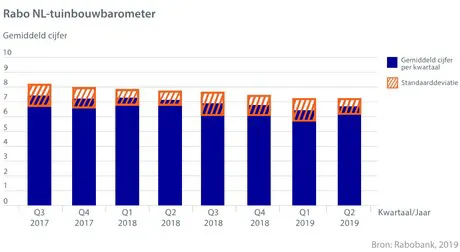The Rabo Horticulture Barometer in the first quarter of 2019 stands at 6.5. That is a considerable decrease compared to the fourth quarter of 2018 (6.8). This is due to the effects of extreme weather conditions as well as the results for year-round cultivation that have been included in the current figure. Although the barometer fell in the course of 2018, it was generally a year with a reasonable return. Export figures are also rising, partly due to re-export. Compared to 2017, vegetable exports (€ 6.6 billion, -0.2%) remained stable. Exports of fruit (6.0 billion euros, + 8.5%) and floriculture (9.2 billion euros, + 3.3%) increased. The figure, the value of the Rabo Horticultural Barometer, is the average figure given by bank employees to the current financial developments within the horticultural sector at this moment.
The figure, the value of the Rabo Horticultural Barometer, is the average figure given by bank employees to the current financial developments within the horticultural sector at this moment.
Financial development per sector:
Greenhouse vegetables
With regard to the greenhouse vegetables, cucumber growers can look back on an excellent 2018. For the start of the new cultivation basically no seasonal financing was required. The season was quite reasonable for bell pepper growers. And for the tomato growers the pricing was disappointing, but the differences are substantial. The profitability of the illuminated crops is clearly lower than the average over the past five years. The result for unlighted crops is also below that average, but the difference is not as great compared to lighted crops. New greenhouse vegetable crops are now in full production and the first signals from the market are reasonable.
Floriculture
In floriculture there are still major concerns about the pricing of Phalaenopsis. Is there really a willingness to take steps towards more sustainable production and investments in improving the market conditions? The results and the mood are clearly better for growers of other potted plants. Green potted plants in particular do benefit from the consumer interest.
Cut flowers
Cut flowers show a strongly varying picture. There are concerns about pricing, especially with gerbera and some rose varieties.
Flower bulbs
Thanks to its location in the north of North Holland, flower bulb cultivation has relatively been less affected by the drought. However, still fewer tulip bulbs were harvested. The forcing companies therefore have difficulty in obtaining sufficient starting material. The prices of the first delivered tulips in the new tulip season are good. And because of the scarcity, the contracts for the spring flowering bulbs are also between reasonable and good. In respect of lily cultivation, there is excess production. The price has fallen sharply due to the stagnation in export of lily bulbs in various countries.
Tree nursery
Tree cultivation can also look back on a good 2018. In addition, there is also confidence in the new year. At various smaller trade fairs in the Netherlands and at the IPM in Essen, entrepreneurs indicate that the demand for their products remains at a good level.
For more information & other findings in the April 2019 Horticulture Update in Dutch, please click here.
